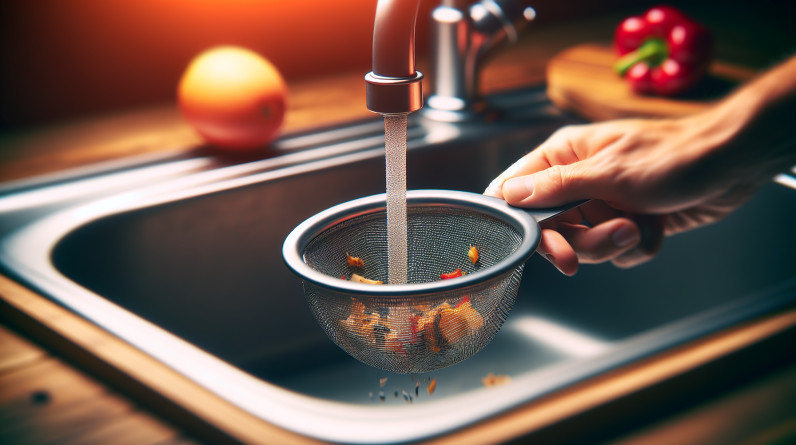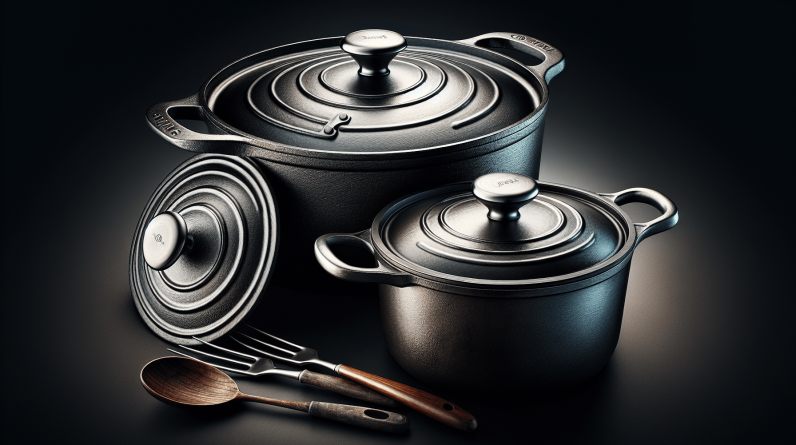In the world of interior design, the possibilities for creating a unique and personalized space are endless. So, when it comes to your kitchen, why settle for a cookie-cutter look? The question on many homeowners’ minds is whether they can mix and match different styles of kitchen furniture to create a cohesive yet eclectic aesthetic. The good news is, yes, you absolutely can! By incorporating various styles into your kitchen design, you have the opportunity to showcase your creativity and create a space that is truly one-of-a-kind. Whether you’re drawn to the sleek lines of modern furniture or the warmth of farmhouse-inspired pieces, mixing and matching can transform your kitchen into a stylish and inviting hub of your home. So, let’s explore the exciting world of blending different furniture styles and uncover the secrets to a harmonious yet eclectic kitchen design.

1. Consider the Overall Theme and Style
1.1. Determine your preferred style
When it comes to designing your kitchen, it’s important to determine your preferred style before diving into any changes. Consider the overall aesthetic you want to achieve and the atmosphere you desire in your kitchen. Are you drawn to a rustic farmhouse look, a sleek and modern design, or a combination of different styles? Taking the time to clarify this will help guide your decision-making process and ensure that all the elements in your kitchen work harmoniously together.
1.2. Evaluate your existing kitchen decor
Before exploring different design themes, take a close look at your existing kitchen decor. Assess the colors, furniture, and accessories currently in place. This evaluation will help you identify any style elements that can be incorporated into your new design. It may also reveal any specific styles or themes that clash with your vision, allowing you to make informed decisions about what to keep and what to replace.
1.3. Research different design themes
To further define your desired style, take the time to research different design themes. Look for inspiration in magazines, online platforms, and home improvement websites. Explore various kitchen styles such as traditional, contemporary, industrial, Scandinavian, or eclectic. Pay attention to the elements that resonate with you and make note of any specific design features you’d like to incorporate into your own kitchen.
1.4. Identify the main style elements
Once you have gathered inspiration and explored different design themes, it’s time to identify the main style elements that appeal to you. This can include specific colors, materials, patterns, or furniture pieces. By pinpointing these key elements, you will have a clear vision of what you want to achieve in your kitchen design. Keep in mind that these elements will serve as a foundation for mixing and matching different styles seamlessly and cohesively.
2. Understanding the Role of Contrast and Cohesion
2.1. Emphasize contrast for visual appeal
Contrast plays a significant role in creating visual interest in your kitchen. By combining different styles, materials, and finishes, you can achieve a striking contrast that adds depth and character to your space. Explore contrasting color schemes, such as pairing dark cabinets with light countertops or vice versa. Mix sleek, contemporary furniture with rustic, vintage-inspired pieces for an eye-catching juxtaposition. The key is to find a balance between contrasting elements without creating a visual overload.
2.2. Achieve cohesion through complementary elements
While contrast is important, it’s equally crucial to achieve cohesion in your mixed-style kitchen. Complementary elements help tie different styles together and create a cohesive look. Look for common design elements or colors that can be repeated throughout your kitchen. For example, if you have a modern stainless steel refrigerator, consider incorporating stainless steel accents or fixtures in other parts of the kitchen. This creates a sense of unity and makes the different styles feel intentional rather than haphazard.
2.3. Balancing the mix without overwhelming
The key to successfully mixing different styles in your kitchen is to strike a balance between them. Avoid overwhelming the space with too many contrasting elements. Instead, carefully choose a few key pieces or design features from each style and integrate them strategically. Consider focusing on one or two main styles while using others as accents or supporting elements. This will create a harmonious and visually pleasing balance that celebrates the combination of different styles without overwhelming the overall aesthetic.

3. Exploring Mixing Materials and Finishes
3.1. Consider the durability and functionality
When mixing materials and finishes in your kitchen, it’s important to consider both durability and functionality. The kitchen is a high-traffic area where spills, heat, and moisture are common. Opt for materials and finishes that can withstand these conditions and are easy to clean and maintain. For example, if you have young children or frequently cook, choose countertops that are resistant to stains and scratches. Additionally, consider the functionality of the materials. For instance, a combination of wood and metal can create an interesting mix of textures while being durable and practical.
3.2. Experiment with different materials
Mixing materials is an excellent way to introduce variety and visual interest in your kitchen design. Explore the possibilities of combining different materials such as wood, stainless steel, glass, tile, or stone. For example, you can have wooden cabinets paired with a sleek stainless steel countertop or incorporate a glass backsplash to complement a colorful tiled floor. By experimenting with different materials, you can create a unique and personalized kitchen design that reflects your style and taste.
3.3. Harmonize finishes for a cohesive look
While exploring different materials, it’s important to ensure that the finishes of these materials harmonize well together. Consider how different finishes, such as matte, glossy, brushed, or polished, interact with each other. Aim for a cohesive look by choosing finishes that complement each other rather than clash. For example, if you have a polished chrome faucet, consider coordinating it with brushed nickel cabinet handles. This attention to detail will contribute to a harmonious overall design in your mixed-style kitchen.
4. Combining Traditional and Modern Elements
4.1. Incorporate classic pieces into a contemporary setting
Bringing together traditional and modern elements in your kitchen design can create a captivating and unique space. Consider incorporating classic pieces, such as a farmhouse sink or a vintage-inspired light fixture, into a contemporary setting. These classic touches add character and warmth to a modern kitchen, breaking up the clean lines and adding a touch of nostalgia.
4.2. Add modern touches to a traditional kitchen
On the other hand, if you have a more traditionally styled kitchen, don’t hesitate to introduce modern touches to give it a fresh and updated look. This can be done through the addition of sleek appliances, contemporary light fixtures, or minimalist cabinet hardware. The contrast between the traditional elements and the modern touches will create a dynamic and visually appealing space.
4.3. Striking a balance between old and new
The key to successfully combining traditional and modern elements is striking a balance between the two styles. One way to achieve this is by layering the different styles throughout the kitchen. For example, maintain traditional cabinetry while opting for a modern countertop material or vice versa. Another approach is to use traditional colors and patterns with modern furniture or decor pieces. By finding a middle ground, you can create a kitchen that feels both timeless and current.

5. Mixing Colors and Patterns
5.1. Understanding color theory and psychology
Color plays a vital role in setting the mood and creating a cohesive design in your kitchen. Understanding color theory and psychology can help you make informed decisions when mixing colors and patterns. For example, warm colors like reds, oranges, and yellows can create a cozy and inviting atmosphere, while cool colors like blues and greens can evoke a sense of calmness and serenity. Consider the emotions and ambiance you want to convey in your kitchen and select colors that align with those intentions.
5.2. Choosing a color scheme
When mixing colors, it’s important to choose a color scheme that allows for both contrast and unity. One approach is to use complementary colors, which are opposite each other on the color wheel, to create a striking contrast. For example, pair blue cabinets with orange accents or yellow walls with purple accessories. Another option is to use analogous colors, which are next to each other on the color wheel, to create a more harmonious and subtle color scheme. For instance, combine various shades of greens and blues for a tranquil and cohesive look.
5.3. Introducing patterns and textures
Incorporating patterns and textures into your mixed-style kitchen can add visual interest and depth to the space. However, it’s important to use them thoughtfully to avoid overwhelming the design. Start by selecting one or two primary patterns or textures and use them sparingly throughout the kitchen. This can be in the form of a patterned backsplash, textured cabinet panels, or a boldly patterned rug. By incorporating patterns and textures selectively, you can create a cohesive and visually appealing design without overcrowding the space.
6. Managing Scale and Proportion
6.1. Scale considerations for furniture placement
In a mixed-style kitchen, it’s crucial to consider scale when placing furniture and decor pieces. Mixing different styles means you may have pieces of varying sizes and proportions. To avoid a visually unbalanced space, pay attention to the scale of each element and how they relate to one another. For instance, if you have a large farmhouse dining table, balance it with appropriately sized chairs and avoid overcrowding the area with additional furniture. Additionally, consider the functional requirements of each piece and ensure they fit well within the overall layout of your kitchen.
6.2. Managing proportion in a mixed-style kitchen
Proportion is closely linked to scale and refers to the relationship between the different elements within a space. To achieve a visually appealing mixed-style kitchen, it’s important to manage proportion effectively. This can be done by selecting furniture and decor pieces that complement each other in size and style. For example, if you have a sleek modern island, balance it with pendant lights of suitable size and design. By maintaining proportion, you create a sense of harmony and cohesiveness in your kitchen.
6.3. Creating a harmonious visual balance
To create a harmonious visual balance in your mixed-style kitchen, consider the overall composition of the space. Step back and take a holistic view, assessing how the different styles and elements interact with each other. Adjust the arrangement and placement of furniture and decor pieces to achieve a balanced and visually pleasing aesthetic. By fine-tuning the details and striving for a harmonious visual balance, you can create a kitchen that feels well-put-together and inviting.

7. Utilizing Open Shelving and Displaying Decor
7.1. Showcasing decorative accessories
Open shelving provides an excellent opportunity to showcase decorative accessories and infuse your personal style into your kitchen. Consider displaying items such as cookbooks, vintage dishes, unique glassware, or potted plants. These decorative items add a personal touch and contribute to the overall aesthetic of your mixed-style kitchen. Arrange them in a visually appealing manner, taking into account color coordination and proportion.
7.2. Organizing and arranging open shelving
When organizing and arranging open shelving, it’s important to strike a balance between functionality and aesthetics. Group items together based on their purpose or visual appeal. For example, stack plates and bowls together, organize spices in decorative jars, or display a collection of colorful glass bottles. Experiment with different arrangements and play with height variations to create an interesting and visually pleasing display.
7.3. Combining functionality with aesthetics
While open shelving allows for the display of decorative items, it’s important to maintain a level of functionality in your kitchen. Ensure that the items you choose to showcase are useful and practical in addition to being aesthetically pleasing. For example, display frequently used kitchen tools or utensils within easy reach. By combining functionality with aesthetics, you create a balanced and purposeful design in your mixed-style kitchen.
8. Seeking Inspiration from Design Experts
8.1. Explore interior design magazines and websites
When seeking inspiration for your mixed-style kitchen, interior design magazines and websites are valuable resources. Explore different publications and websites that focus on kitchen design. Look for features or articles that highlight successful examples of mixing different styles. Pay attention to the design tips, recommendations, and visual inspiration provided by design experts. This exposure to expert knowledge can help inform and guide your own design decisions.
8.2. Visit showrooms and home exhibitions
Another way to find inspiration for your mixed-style kitchen is by visiting showrooms and home exhibitions. These venues often showcase a variety of kitchen designs, allowing you to see firsthand how different styles can be combined. Take the time to observe the details, furniture arrangements, and color palettes used in these displays. It can be an excellent opportunity to gather ideas and envision how they can be applied to your own kitchen.
8.3. Consult with professional designers
If you’re feeling overwhelmed or unsure about how to proceed with your mixed-style kitchen design, consider consulting with professional designers. Designers have the expertise and experience to guide you through the process and help you achieve the desired aesthetic. They can offer personalized advice, recommend specific furniture or decor pieces, and suggest layout and color schemes that suit your style. With their assistance, you can feel more confident in creating a cohesive and visually stunning mixed-style kitchen.

9. Potential Challenges and Solutions
9.1. Balancing individual preferences with cohesiveness
One potential challenge when mixing different styles in your kitchen is balancing individual preferences with overall cohesiveness. In a household with multiple individuals, each person may have their own design preferences. It’s important to find a middle ground and consider everyone’s input to ensure that the final design reflects the collective vision. Open and respectful communication, compromise, and creative problem-solving can help navigate this challenge and create a space that satisfies everyone’s style preferences while maintaining overall cohesiveness.
9.2. Avoiding visual clutter and overwhelming combinations
Mixing different styles can increase the risk of visual clutter and overwhelming combinations if not done thoughtfully. To avoid this, be mindful of the number of styles and elements you incorporate. Avoid overcrowding the space with too many contrasting pieces. Instead, focus on a few key combinations that work well together. Regularly step back and assess the design as it takes shape, making adjustments as needed. By keeping a discerning eye and editing your choices, you can prevent visual clutter and create a harmonious mixed-style kitchen.
9.3. Adapting and adjusting as your tastes evolve
As your tastes and preferences evolve over time, your mixed-style kitchen may need adjustments to maintain its appeal. It’s important to embrace the flexibility of a mixed-style design and be open to making changes as needed. Stay attuned to your personal style evolution and be willing to experiment with new combinations or additions. With an adaptable mindset, your mixed-style kitchen can continue to reflect your ever-evolving tastes and remain a dynamic and inviting space for years to come.
10. Budget-Friendly Options and DIY Ideas
10.1. Repurposing existing furniture
Creating a mixed-style kitchen doesn’t have to break the bank. One budget-friendly option is to repurpose existing furniture or decor pieces. Look for items in your home that can be transformed or repainted to fit your desired style. For example, an old dresser can be converted into a unique kitchen island or a vintage mirror can be repurposed as a backsplash. Get creative with what you already have to save money and bring a personal touch to your kitchen design.
10.2. Upcycling and refinishing projects
In addition to repurposing existing furniture, consider upcycling and refinishing projects to add character and style to your mixed-style kitchen. Upcycling involves taking discarded items and transforming them into something new and useful. For example, you can turn old wine crates into wall-mounted storage shelves or repurpose mason jars as pendant light fixtures. Refinishing projects involve restoring or changing the appearance of existing furniture or surfaces. For example, sanding and staining wooden cabinets or painting an old table can breathe new life into your kitchen.
10.3. Shopping for budget-friendly pieces
If you’re looking to incorporate new pieces into your mixed-style kitchen, there are budget-friendly options available. Explore thrift stores, flea markets, and online marketplaces for unique and affordable furniture and decor pieces. Keep an eye out for sales, discounted items, or clearance sections in home improvement stores or kitchenware retailers. With a bit of patience and persistence, you can find stylish and budget-friendly pieces that perfectly complement your mixed-style kitchen.
Conclusion
Designing a mixed-style kitchen allows you to create a truly unique and personalized space that reflects your individual style. By carefully considering the overall theme and style, understanding the role of contrast and cohesion, exploring mixing materials and finishes, combining traditional and modern elements, mixing colors and patterns, managing scale and proportion, utilizing open shelving and displaying decor, seeking inspiration from design experts, addressing potential challenges, and exploring budget-friendly options, you can create a stunning and harmonious mixed-style kitchen that is both functional and aesthetically pleasing. Embrace the freedom to mix and match different styles, and enjoy the process of creating a kitchen that is truly yours.










